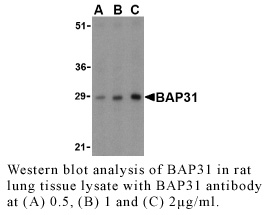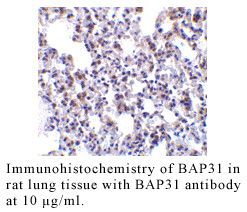Anti-Human B Cell Receptor-Associated Protein 31 (Intermediate D
Data
- -
- -
Antibody DetailsProduct DetailsReactive Species Human Host Species Rabbit Immunogen PN:B500 Formulation This polyclonal antibody is formulated in phosphate buffered saline (PBS) pH 7.4 containing 0.02% sodium azide as a preservative. Storage and Handling This polyclonal antibody is stable for at least one week when stored at 2-8°C. For long term storage, aliquot in working volumes without diluting and store at –20°C in a manual defrost freezer. Avoid Repeated Freeze Thaw Cycles. Country of Origin USA Shipping Next Day Ambient RRIDAB_2828222 Each investigator should determine their own optimal working dilution for specific applications. See directions on lot specific datasheets, as information may periodically change. DescriptionDescriptionSpecificity Rabbit Anti-Human B Cell Receptor-Associated Protein 31 (BAP31) recognizes an epitope in the intermediate domain of Human, Mouse and Rat BAP31. This polyclonal antibody was purified using affinity chromatography. Background Bap31 and the related protein Bap29 are endoplasmic reticulum (ER) and ER-vesicle membrane proteins and members of the B-cell receptor-associated protein family.1,2 These two proteins are highly homologous and can form homo- and heterodimers. Bap31 is thought to be involved in the intracellular trafficking of several molecules such as MHC Class I molecules and CD11b/CD18.3,4 Bap31 may also play a role in the initiation of ER stress-induced apoptosis through its association with caspase-8 via a death effector domain in its cytoplasmic tail, possibly through the promotion of membrane fragmentation and the release of cytochrome c from mitochondria. Bap31 itself contains two caspase cleavage sites and is cleaved during apoptosis. The p20 fragment of Bap31, when expressed ectopically, is also a potent inducer cell death. References & Citations1. Little, E. et al. (1994) Crit. Rev. Eukaryot. Gene Expr. 4:1 2. Kim, KM. et al. (1994) EMBO J. 13:3793 3. Paquet, ME. et al. (2004) J. Immunol. 172:7548 4. Zen, K. et al. (2004) J. Biol. Chem. 279:44924 Technical ProtocolsCertificate of Analysis |
Related Products
- -
- -
 Products are for research use only. Not for use in diagnostic or therapeutic procedures.
Products are for research use only. Not for use in diagnostic or therapeutic procedures.




